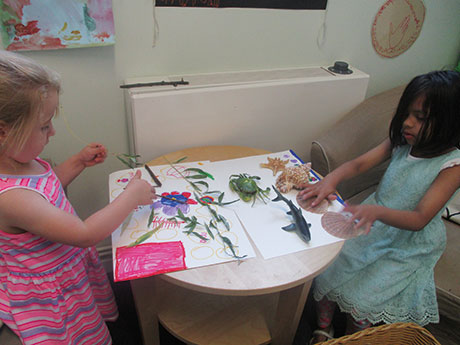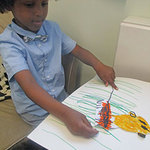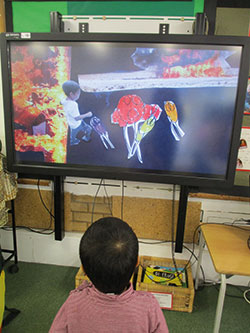
Download the PDF of 'We've explored...animation'
Once upon a time there was a butterfly,’ narrates Mia as a hand-drawn butterfly flies over a backdrop of sticks and twigs. ‘The butterfly landed on the rainbow. The butterfly landed on the aeroplane.’


Zakariya, who has included a photo of himself in the film ‘Monster Land’, uses his fire breath to breathe on the approaching monsters and leave them dead on the floor. And under Mika’s directorship, dramatic music accompanies a large, red hand as it takes a potato, spins round and eats it.
These intriguing films, and others, are the result of a group of children spending a term absorbed in exploring animation, planning and, ultimately, making their own films at Rachel Keeling Nursery School in Bethnal Green, east London.
Deputy head teacher Maria Ioannou explains that the school follows Vivian Gussin Paley’s Helicopter Stories approach, making the children very used to telling their own stories, having them scribed and acting them out. To build on these experiences and bring their stories to life, the practitioners decided to help the children create their own animated films. ‘We understand that learning is a process and children need ample opportunities to return to the experience over time, taking increasing ownership of their learning,’ she says.
FILM STUDIO
Supported by Ms Ioannou, a group of nine children, who all receive the Early Years Pupil Premium, turned her office into a studio in which to create their own short films, and embarked on research to discover what animation is. Many of them drew on their experiences of watching Disney films and spoke particularly about The Lion King and Moana. Practitioners gathered a collection of flick books to show the children how a series of pictures can appear to move as the pages are turned rapidly. The children were fascinated by them.
A parent who is an animator also helped their investigations by directing them to YouTube information on how to construct simple yet effective animation on paper. They also went online to look at other examples of animation in order to gain ideas and inspiration for their own creations.
The children were invited to tell their own stories to Ms Ioannou either alone or with their friends. These varied tales included stories inspired by the film Moana and about balls, tigers and spiders. ‘The wide range of stories reflected the children’s different interests, characters and experiences,’ Ms Ioannou says. ‘One girl told a story about going to Asda, and recruited her friend to help her do the  voiceover, whereas a boy who is very physical told a story about a monster, which really represented him. He is gregarious and this was reflected. The youngest child involved told a story that was short and simple – there was no pressure to tell a long story.’
voiceover, whereas a boy who is very physical told a story about a monster, which really represented him. He is gregarious and this was reflected. The youngest child involved told a story that was short and simple – there was no pressure to tell a long story.’
The children planned their stories on A5 paper and Ms Ioannou worked individually with them to identify the main characters and the possible props to illustrate them. They then focused on how to represent their ideas graphically and used a range of methods, from drawing their characters and settings, gathering real objects, and finding cuttings and photographs.
‘We used three types of media – collage, their own drawings and real objects,’ says Ms Ioannou. ‘The children like to do 3D modelling with clay and woodwork, and we thought it would be nice to add different materials. The children enjoyed thinking about what they wanted and collecting items such as shells and twigs. One child drew a rainbow and a butterfly but wanted to have a picture of an aeroplane, so I showed her how to research pictures on Google. The film of the tiger has a photograph of his keyworker in it.’
SUPPORTING AND SCAFFOLDING
The children could choose when to work on their animations during their nursery day and would often drop in to their ‘studio’ to add or alter their creations. ‘The children were given choices and were enabled to decide and direct their own animation. They would have their own ideas and I’d support and scaffold them,’ explains Ms Ioannou. ‘It was a long project sustained over three months because the children took ownership of it, reflected on their work and supported each other with their films. They were very engaged and involved.’
As the project continued, Ms Ioannou noted how the children developed in confidence in making choices and communicating their ideas. She feels this was because they were working in a nurturing but challenging environment and with an adult who was available and sensitive to their needs.
To make the actual films, the children simply used iPads and a Stop Motion Studio app, which they found surprisingly straightforward. The children positioned their characters and objects on selected backdrops and could then photograph them as they made slight movements. The program also enabled the children to provide their own voiceovers or audio directly to their films and add music and sound effects. They could also include their own film titles and credits. Ms Ioannou edited the clips together and then the children previewed their films and made any desired changes.
FINISHED PRODUCT

Once the children were happy with their films, they wrote invitations for their friends and family to come to a special screening of the finished animations at the nursery school.
‘It gave the children a real sense of pride because they were able to share their work with their base classes and key workers. We also showed them on a large screen to their parents,’ says Ms Ioannou. ‘I think the animation project gave the children high levels of self-esteem, as they helped each other to reflect and organise their work and they gained pride and ownership from the finished product. The parents also loved seeing the children’s work.’
Each child was given a DVD copy of their film to keep and share and they are also able to access them on the nursery school’s website. Many of the children who were involved left the setting to start school in September, but those that remain are continuing to show an interest in animation. Now the nursery school staff are going to be challenged to create their own animations on an upcoming inset day.
‘We found the app very simple to use and would like to inspire others to do it too,’ says Ms Ioannou, who wants the staff to experience creating their own animations and gain the confidence to lead such projects themselves.
‘What has resulted is the most unique, individual animations – some quite surreal,’ she says. ‘One parent likened one animation to a David Lynch film.’
RESOURCES
- Children’s own stories on A5 paper
- iPad
- Stop Motion Studio app, https://play.google.com/store/apps/details?id=com.cateater.stopmotionstudio&hl=en_GB
- Victorian Style Moving Picture Flick Books, priced £5.44, are available on Amazon
- Mark-making tools such as felt-tip pens and pencils
- Paper
- Scissors
- Natural materials such as twigs, leaves and shells
- Collage materials, including different types of paper and fabric
- Images that the children researched online
MORE INFORMATION
View the children’s films at: www.rachelkeeling.towerhamlets.sch.uk/our-films.html
View paper animations at: https://vimeo.com/andersenmstudio
Flipping Out: The Art of Flip Book Animation by David Hurtado
 Digital Filmmaking for Kids by Nick Willoughby
Digital Filmmaking for Kids by Nick Willoughby
Stop-Motion Animation: How to Make and Share Creative Videos by Melvyn Ternan









